HOCKEY SKILLS INSTRUCTION PAGE
Shooting: Basic instructional fundamentals
have been limited to two primary stick and blade functions:
1. shaft and blade
speed,
2. shaft and blade flex.
It is important to fully comprehend these
basics since all hand positions, grip positions (fingers - thumb), arm and body movements are to
maximize either one of, or a combination of these components.
While descriptive
names have been provided to describe each shot; (slap, wrist, snap, flip), we
often miss-understand the actual bio-mechanics of the shot due to the nature of
it's
description. It is easy to understand that "slap" shot describes the
slapping action of hitting the puck and the "snap" shot describes the
snapping action of the blade hitting the puck.
The "wrist"
shot becomes confusing in that most players do not really understand the true
action of the wrists when shooting. Hence the miss-labeling of the
"sweep" shot. Most people assume that this shot which hinges off of
the top hand and is executed using a predominant bottom hand push is a wrist
shot. IT IS NOT!! The "TRUE" wrist shot hinges through the middle of
the top and bottom hand due to the push/pull and wrist rotation during the
delivery and follow-through. In actuality, the term "wrist"
shot is actually a simplified description. It is in essence a shooting style
that utilizes shaft and blade speed through physical and bio-mechanical means to
propel the puck through the air or along the ice as fast as possible. In order
to due this we MUST have correct hand placement and grip positioning on
the stick, as well as correct push/pull action of the arms and perfect wrist
action.
A slap shot is a shaft flex shooting skill that
if done correctly incorporates blade flex (blade action and rotational flex;
shaft flexing rotationally as the blade flexes). This maximize this shot a
player must have superior grip and wrist strength. Follow through delivery shaft
speed increases shot velocity due to impact speed and the resulting shaft flex.
There are
two basic snap shot shooting styles.
One method utilizes shaft flex while the other utilizes primarily shaft
speed (some shaft flex) and blade speed.
The following information describes primary
fundamental elements used in the shooting action; whether wrist, snap or slap.
|
Skill Basics Table |
| Fundamental |
Shooting |
| 1 - V Grip
|
"V" Grip top hand position on
stick. Position stick squarely between thumb and index finger much like
position used when shaking hands. Used in wrist shot and puck
handling. Superior grip due to finger and thumb position (maximum digit
strength), wrist strength and control. In the diagrams
shown below, shown is the "V" grip on the left and the incorrect
"palm-up" grip used by most beginning and some intermediate
players. The "palm-up/thumb on top" grip must NOT be used when taking a wrist
shot! An integral part of this shot is the position of the hand on top of
the stick. The "picky" finger is positioned such that it barely fits on the
top of the stick. 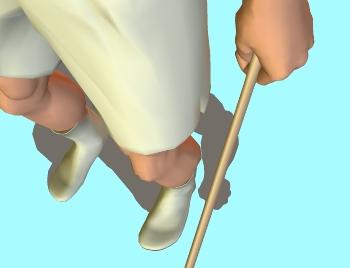
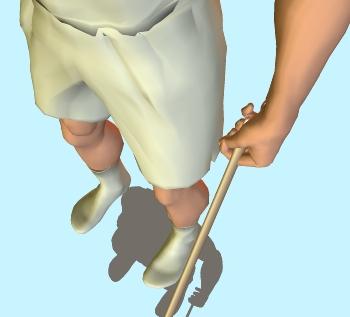
|
| 2 - Top of Stick
Pictures to come |
3 finger grip; Top of stick is positioned in
top hand palm so that pinky finger is at the very end of the stick in a
half on/half off position. This allows for maximum top hand rotation and
freedom of movement within the wrist for alternate applications as well. |
| 3 - 3 Grips
(hand separation / bottom hand position)
Pictures to come
|
1 - Position (1) one used in most
puck-handling skills that involve either speed or "crossed
hands", fine puck control movements left and right using top wrist as
well as wrist shot (medium and long range - some short game applications).
Holding onto your stick with just your bottom hand, turn your stick
upside down placing the top of the stick upright on the back of the
top hand glove with knob touching . Slide your bottom hand down so that
your elbow (which is against the side of your stick) barely touches
the back of your glove. This stick/puck handling / shooting
position is one that creates the most shaft speed due to the push / pull
action of the top and bottom hands as well as allows for maximum skating speed due to the freeing up of the
knees (room under the bottom hand). A weak position for stick handling in traffic but allows for
freedom of movement of the top hand for puck control, as well as superior
puck control when using top hand to open and close the blade of stick (bottom
hand loose) so as to position the puck correctly relative to the
body. Another method of measuring (SHOWN BELOW) is to position the
puck to the forehand side of the body, close the outside shoulder and
rotate the upper body towards the puck. Body weight should be loaded over
the inside leg. Closing the outside shoulder will place the top hand in
front of the inside leg. The bottom hand will have to slide up to accommodate
this new position. If we then measure the distance between the hands you
will find that this will be the (1) position.
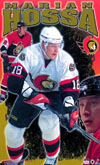
D1/Pos
1
D2 - Stick handling Pos 1 D3 -
Stick Handling Pos 1
D1 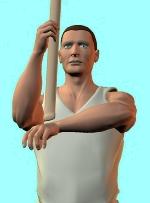 D2
D2 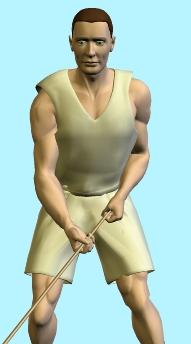 D3 D3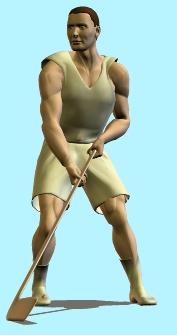
|
| 2 - Position (2) two position on stick. As
above, place stick upside down but instead of placing stick on top of
glove assume "V" grip position with top of stick inside of glove
sliding bottom hand down so that elbow touches back of glove. You will
notice that this position is several inches further apart than position
(1). This grip is used for Wrist action snap shots, saucer passes as well
as lateral skating skills (left to right) where quick puck movements side
to side are necessary. This grip provides medium wrist strength and
stability which is good for moderate puck movement while providing
slightly less than maximum speed capabilities due to interference with the
knee action of the crossover leg. Players that carry the puck in this
position most often crossover flat (hitting the ice with the
"flat" of the skate blade as opposed to the toe). Body position
has to vary slightly with the skater compacting (getting lower) and
leaning forward (not from the butt but from increased flexion of the
ankle, knee and hips while keeping the head erect) through the center line
of the body (through the body from head to toe). This position also allows
the player to snap the puck accurately while moving away from the net,
shooting off their off-wing due to the ease in top hand extension and
rotation away from the body.
D4 - Stick Handling Pos
2
D5 - Stick Handling Pos 2
D4 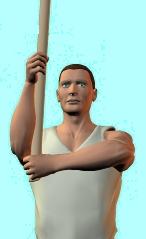 D5
D5 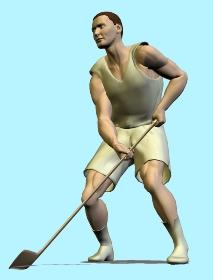
When comparing both position 1 and 2 diagrams, we can
see that the top and bottom hands are separated more. In position 2
the top hand is slight more to the outside of the body and higher up on
the hip. This position allows for greater puck control and strength yet
still allows the player to move the puck and stick (top hand) across the
body but it becomes necessary to skate in a more compacted / forward
aligned position.
D6 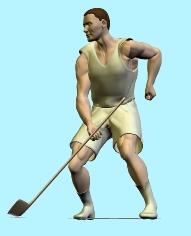 D7
D7
In diagram 6 I have tried to exaggerate the widening of
the hands which is necessary when changing positions by moving the
elbow/arm of the top hand.
The bottom hand would stay in the same relative position in front of the
body but the top hand would keep gripping the stick pulling the shaft
through the bottom hand (grip loosens so that this is possible) in order
to set the desired hand gap. Again the top hand is in a "V"
grip position.
|
| 3 - Position (3) three position of stick.
Taking the stick in a "V" grip position, hold the stick out and
away from the body on the bottom hand side (if you shot right handed then
under the right arm with pinky side of your top hand glove (left hand)
barely touching the edge of your shoulder pad. Bottom hand (right hand) is
extended straight then grip stick. You will now have your hands fairly
wide apart. This position is used for stick handling (explosive puck
movements side to side while in a wide basic gliding stance), as well as
for snapping the puck (shaft flex snap as opposed to shaft speed/flex and
blade speed and in position 2. There is a position on the stick
halfway between 2 and 3 which is (2.5 - obviously hey) where long game
striding is maximized while carrying the puck. This position can be used
for snapping the puck (North American style) as well.
D8
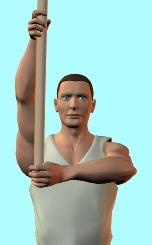 D9 D9 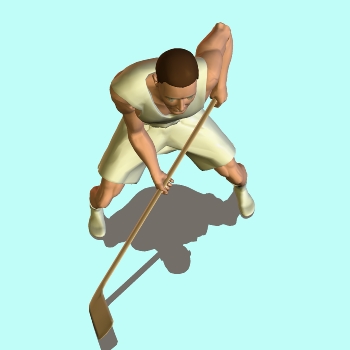
D10 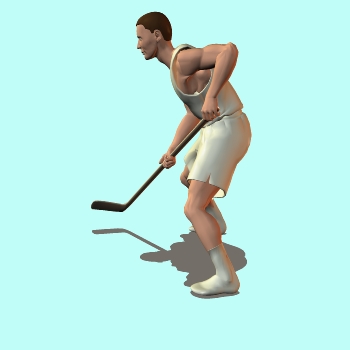
Diagram 9 and 10 shows the player in
stick-handling position 3 in a "neutral" position.
|
|
4 - Grips
(top hand 3
basic
(Pictures
to come) |
1 - first basic position is the
"V" grip position as explained above. This position allows for
maximum wrist and finger strength and endurance while finessing the puck
with the top wrist (bottom hand light touch - like "handling
and egg") while using the bottom hand for support (finger touch).
This grip is used when sculling the blade back and forth when skating
backwards so as to keep the puck in front of the body (which allows for
quick passes both to forehand and backhand sides). |
| 2 - second basic position is the "8th
Turn". This position allows for quick wrist action such as when
toeing the puck (although toeing the puck utilizes a slightly different
thumb position for added stability) or snap the puck off a
"draw" (no...not a face-off but when drawing the shaft though
the bottom hand using a pulling action off the top hand so as to create
grip separation for power). Starting a "V" grip position, loosen
the top hand grip so that the stick can rotate inside the palm of the glove.
Position the stick in front of your body so that the blade is pointing
upwards towards a 12 o'clock position. Taking the
stick in the bottom hand rotate the toe down so that the blade would align
to the 10:30 hour hand position. The lower edge of the shaft (remember that it
has 4 corners) semi-locks into the thumb knuckle crease. This will be
approximately 1/8th of a turn. Pinky is again positioned in the 50/50
position as explained above. |
| 3 - third position is the "Quarter
Turn". This grip is used for maximal slap shot power. Starting a
"V" grip position, loosen the top hand grip so that the stick
can rotate in the glove. Again, using the 12 o'clock example explained
above, rotate the blade forward so that the blade of the stick
aligns with the 9:00 hour hand position. The
thinner edges of the shaft lock into the fingers and the thumb. You should
be looking down at the corporate logos located on the side of the stick.
The stick is now in the maximum flex position. The top hand and
wrist should be straight with the shaft being directly below the wrist
when gripped by the fingers and the thumb. Sliding the bottom hand
down into the desired position (shaft flex point....flex the stick and
find middle of the bend) grip the stick rotating the bottom hand
(clockwise right, counter clockwise left) so that the thumb crease in palm
of your hand is against the edge of your shaft. This position places the
hardest part of your hand against the shaft which transfers more power
into the shot. The fingers provide the grip strength with minimal support
from the thumb (this relates to the bottom hand). Shooting from this
rotated position puts and incredible amount of rotational torque on the
fingers of the bottom hand and you will find that if you are not accustom
to shooting from this grip position, your finger muscles (didn't think
that you had any did you) will become very fatigued. In this rotated
position, the blade of the stick will hit the ice first causing the
rotational torque which your finger strength has to counter and hold
(primary load on the middle and third finger). This
technique utilizes 100 percent of the stick (shaft flex, blade flex and
rotational flex [shaft and blade combined]). However, impact point on the
blade should be at the 2/3 blade point from the heel (divide the blade
into three equal sections and at the seam of the second section from the
heel would be the impact point). PICTURES TO
FOLLOW SOON. |
| Wrist Shot |
We practice the one hand wrist shot. We did
this by standing square to the boards or partner and with the bottom hand
in a (1) position, and with the top of the stick in front of the body, we
swept the puck through using the arm and at the end of the movement,
turned the wrist over to put spin on the puck. The started on the heel of
the stick. This wrist action is the foundation of the wrist shot. The
bottom hand provides stability in the cupping action when moving the puck
forward, the bottom hand provides blade rotation (opening) for elevation
(height of shot) and then provides the spin (blade action) on the puck by
rotating over. This blade speed assist not only in extra puck velocity but
accuracy as well since the follow-through has to be at the correct height
so as to maximize the use of the blade as the puck travels down it. The
top hand assists the shaft speed (the wrist shot is based on shaft speed)
by extending on the loading phase (as the puck is brought forward) and
then by pulling the top of the stick back as the bottom hand extends
providing the "whip" action, increased further by the
"breaking" of the wrists (turning over the the wrists) with the
thumb of the top hand ending up against the elbow the of the bottom hand
to complete the follow through. PICTURES AND MORE TO FOLLOW. |
| Stick Handling / Puck Handling |
It is important to understand the basic
difference between stick handling and puck handling. We can say that puck
handling is controlling the puck in every possible situation while
skating. That is; stopping with, accelerating with, crossing over with,
striding with, pivoting with, etc. Stick handling describes the
basic movements necessary to either; move the puck into a shooting or
passing position, or to move the puck in such a way (laterally,
vertically, or diagonally [width and depth}) so as to move the puck around
an opponent.
Basic stick handling and/or puck handling is based on 5 primary bottom / top hand
positions with the slap shot being the 6 basic position (remember that
this a TRUE and separate shooting specific position). Three of these basic positions correspond with
basic shooting fundamentals, which are described above. For example: 1-pos
= wrist shot, 2-pos = snap/sweep shots, 3-pos=snap shot. These
positions are created by widening or narrowing the distance between the
top and the bottom hands by pulling up or pushing down on the top part of
the stick with the top hand. Many players change their stick/puck handling
grip separation by moving the bottom hand up and down on the shaft of the
stick and maintaining the top hand position against their hip. THIS IS INCORRECT!.
It is also important for players to understand hand
dominance. When does the top hand take control and when does the bottom
hand take control? A simple rule is to think of the top hand as
controlling the blade action of the stick (opening or closing the blade)
and the bottom hand is to control the shaft of the stick (forward and
back, or side to side). Grip tension is another important factor to
consider when controlling the puck. "Soft hands" is usually a
term that describes the light bottom hand grip (finger tip
action) only tensing the bottom hand on the extremes of movement
(direction changes forward/backward, side to side) with more of the stick
control coming from the top hand. A common mistake made by players is to
"over-grip" the stick continually which creates the illusion of
"heavy hands".
As well, upper body separation is another critical
factor in stick handling and puck control. Movement off the elbow or the
top hand is critical to maximum side to side strength (on the puck) and
quickness (with the puck). Upper body separation allows the player to move
the upper and lower body separately which allows for deceptive movements
in one on one situations. MORE TO FOLLOW!
|
| |
|
| |
|
| |
|



 D2
D2  D3
D3
 D5
D5 
 D7
D7
 D9
D9 
